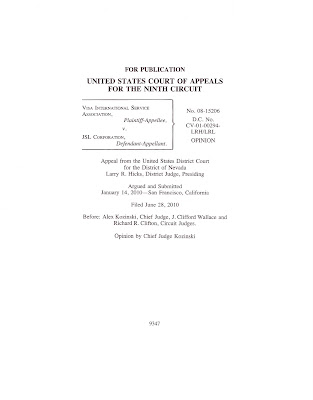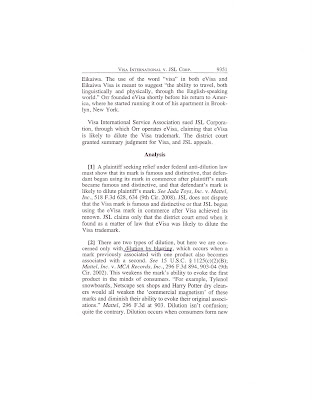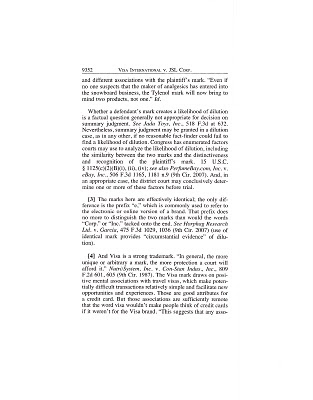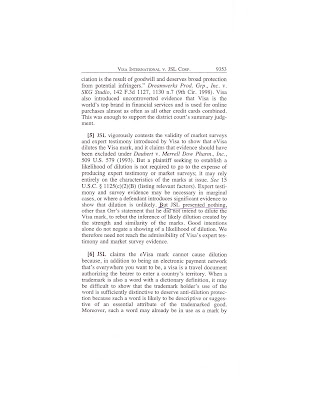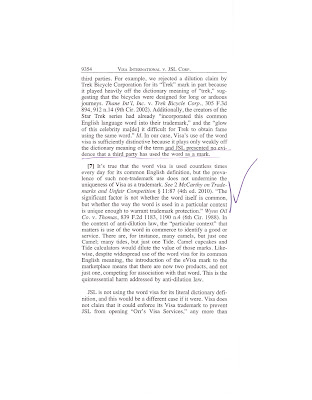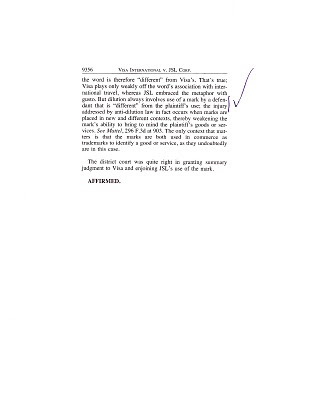


SUMMER 2010: AT THE BEACH A Primer on the Selection and Clearance of Trademarks© Copyright 2010, William E. Maguire. All Rights Reserved.

 INTRODUCTION:
INTRODUCTION: Surfboards, swim fins, wetsuits, t-shirts, swimsuits, sunglasses, sunscreen, bottled water, sandals, umbrellas, towels, volleyballs, ice chests........ sounds like another summer day at the beach! To the savvy, business entrepreneur, however, these beach accessories/necessities are the breeding ground for commercial exploitation. Not far behind in this consumer petrie dish of sand and capitalism is the need to select a trademark by which the item exploited will be known, e.g., HOBIE® surfboards, O'NEILL® wetsuits, OAKLEY® sunglasses, TOMMY BAHAMA® beach towels, hats, shirts and shorts, VESTAL® wristwatches, MIKASA® volleyballs, and COPPERTONE® sunscreen and tanning lotions. This article will highlight some famous trademarks in the sun, sand & surf and will briefly address the legal and business issues with respect to the selection, clearance and registration of such trademarks.


 TRADEMARKS DEFINED
TRADEMARKS DEFINED A trademark (or mark) is defined as any word, symbol, slogan, or device (such as a design), or a combination of them, used by a manufacturer or merchant to identify his goods or services and to distinguish them from those manufactured, sold or serviced by others. COPPERTONE® and SPEEDO® are excellent examples of 'word' marks. "TAN DON'T BURN" is an example of a 'slogan' mark. A logo or design such as the famous COPPERTONE girl and the dog is an example of a 'design' mark. An example of a service mark is ESPN® for the "entertainment services, reporting and sports programming services rendered through the medium of television." Such a service mark as ESPN® can also be exploited and serve as a trademark (i.e., for clothes (shirts, hats, sweaters; prerecorded dvd's and cd's; beach bags, beach towels, etc.). In the U.S., trademark rights are acquired through use (e.g., by selling or transporting your product in commerce with the mark attached or on a label). In addition, under certain circumstances "color" can be a trademark. Examples outside the surf/beach industry are the color "pink" for fiberglass insulation and "green" for dry cleaning pads.
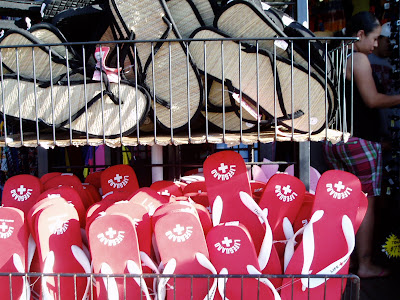 SELECTION AND CLEARANCE
SELECTION AND CLEARANCE The selection of a trademark is the first step that a merchant undertakes to create an identity for his/her surfboard or swimsuit, etc. The clearance of a trademark is the process of determining whether or not the trademark is available and is not being used by someone else as a trademark. This clearance process cannot be overemphasized in its importance. Ignoring this vital step can lead to a multitude of problems and expense. In the clearance of a trademark, a two-step process is suggested. The first step is to conduct an on-line computer trademark search of the mark. This on-line search is further clarified by identifying the goods sought to be used or sold as trademarks are categorized by classification. In the United States, the federal government has adopted the International Classification system. Toys, sporting goods, volleyballs swim fins, bodyboards, and surfboards are in Class #28. Swimsuits and beach apparel and clothing are in Class #25. Backpacks, beach bags and gear bags are in Class #18. Posters, magazines, books, trading cards, and other printed matter and publications are in Class #16. DVD's, compact discs, video game software (including downloadable software over a global computer network), surfing and skateboard helmets are in Class #9. Therefore, if you are planning to sell surfboards, apparel and gear bags, then you will want to conduct an on-line search of Classes # 28, 25 and 18. The on-line search is often called a "knock-out" search. This is because the on-line search is a quick and relatively inexpensive way to determine if the mark is already being used. These on-line searches are available on the internet, e.g., at www.uspto.gov, or can be performed by commercial search firms and law firms.
If your mark appears free of conflicts after conducting an on-line search, the next level of search is the full search, which is obtained from commercial search firms like THOMSON COMPUMARK and CT CORSEARCH. The full search will search the federal database of trademarks at the Patent and Trademark Office, State trademark registrations, common law sources such as phone directories, the internet and Dun & Bradstreet listings, plus internet domain name registrations. If your mark still appears clear of conflicts after a full search, then you can be fairly certain that you can adopt and start using your mark.
CAVEAT: These searches are not guarantees of the absence of conflicting marks, but they do allow a merchant to make a more informed decision in the clearance of a trademark.
 FEDERAL TRADEMARK REGISTRATION
FEDERAL TRADEMARK REGISTRATION To obtain maximum protection, it is best to register your trademark or service mark. In the U.S., your greatest rights can be obtained with a federal trademark registration. If you are only conducting business within one state, e.g., California, it is possible to register your mark with the California Secretary of State. However, if it is your intent to do business across state lines or in foreign commerce (or if you are already doing business across state lines or in foreign commerce), then the prudent thing to do is to file for a federal trademark application with the U.S. Patent and Trademark Office located in Alexandria, Virginia.
An application for registration of a trademark must be filed in the name of the owner of the mark. The on-line application is both recommended and preferred by the USPTO at www.uspto.gov. In fact, a written application filed via U.S. First Class Mail or the like, e.g., the old fashioned way, is more costly than filing on-line. The applicant must submit: (a) an application; (b) a drawing of the mark; (c) the required filing fee (which is $325 per mark per class at this time for an application filed on-line, or $375 if filed the old fashioned way). The applicant will also incur attorneys fees, typically a fixed fee, should an attorney be hired to file the application(s). After the mark is registered in the U.S., it is important to give notice of this fact by placing the registered trademark symbol, "®", adjacent to the mark. Prior to registration, it is also advisable to use the symbols, "TM" (for trademarks) and "SM" (for service marks).
The chief advantages of a federal registration include:"Constructive Notice" nationwide of the registrant's claim to ownership of the mark. This basically eliminates the good faith defense of an infringer who claims to have lacked actual knowledge of the registered mark.
Registration is also evidence of (a) the validity of the registration; (b) the registrant's ownership of the mark; and (c) the registrant's exclusive right to use the mark in commerce in connection with the goods or services.
Registration also entitles the registrant to (a) file a lawsuit for infringement of the mark in Federal Court; (b) prevent importation of goods bearing an infringing mark; and (c) use the registration as a basis for registering the same mark in certain foreign countries.
Trademark registrations are valid for 10 years subject to certain use and filing requirements, and are renewable every 10 years, also subject to continued use and renewal filing requirements.

FOREIGN TRADEMARK REGISTRATION If your product is distributed internationally, then you must, by and large, register your mark(s) in each country where you plan to do business or are doing business. Is this expensive? Yes! On the other hand, the alternative is the potential loss of the ability to sell your product in those countries where a third party has filed a prior application for your mark(s). Therefore, foreign trademark protection is typically obtained on a country-by-country basis. Unlike the U.S., however, trademark rights in many foreign countries are obtained by registration rather than use. This further necessitates the importance of filing for marks in foreign countries as soon as possible.
One notable alternative to the typical practice of registering trademarks on a country-by-country basis is the European Community Trade Mark Application which has been available since January 1, 1996. By obtaining a Community wide trademark registration, an owner of a U.S. registered trademark, for example, can potentially save both time and money otherwise invested in registering a mark in each separate European country and can thus hopefully attain maximum protection for its trademarks in overseas markets at a minimum of cost.
CONCLUSION Whether you are selling products or services, it is very important to be aware of your trademark and/or service mark and their value. In a competitive business environment, the potential for economic loss is tremendous if trademark rights are not acquired, evaluated, protected and maximized. While this article does not portend to cover all the intricacies of trademark law, hopefully it has helped to shed some light on this area of the law which is of paramount importance to the business owner.
---William E. Maguire is a sole practitioner in Los Angeles and concentrates on trademarks, copyrights and licensing. He can be reached at:
email: maguire@artnet.net
web:
www.TrademarkEsq.com
***** ***** *****















